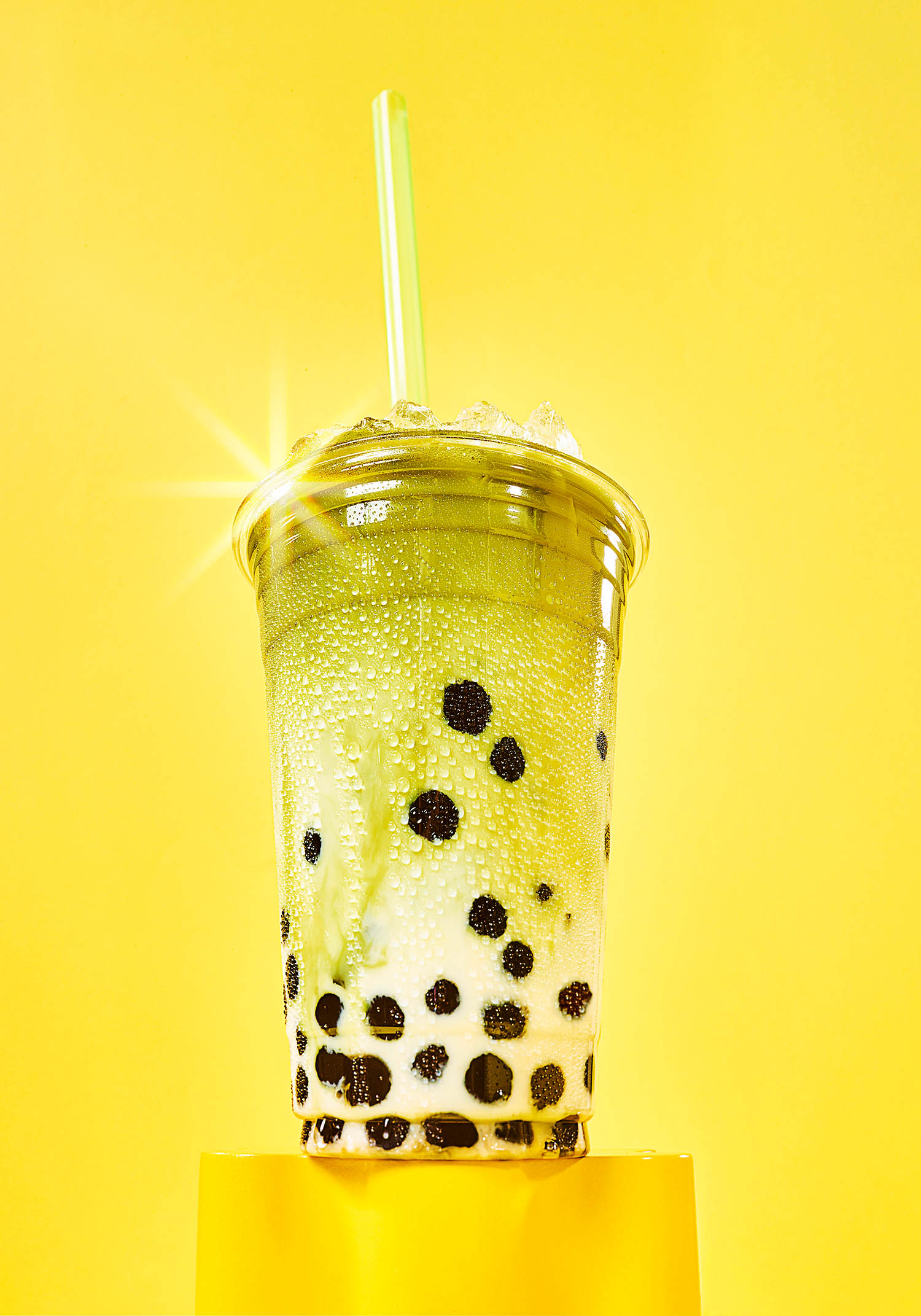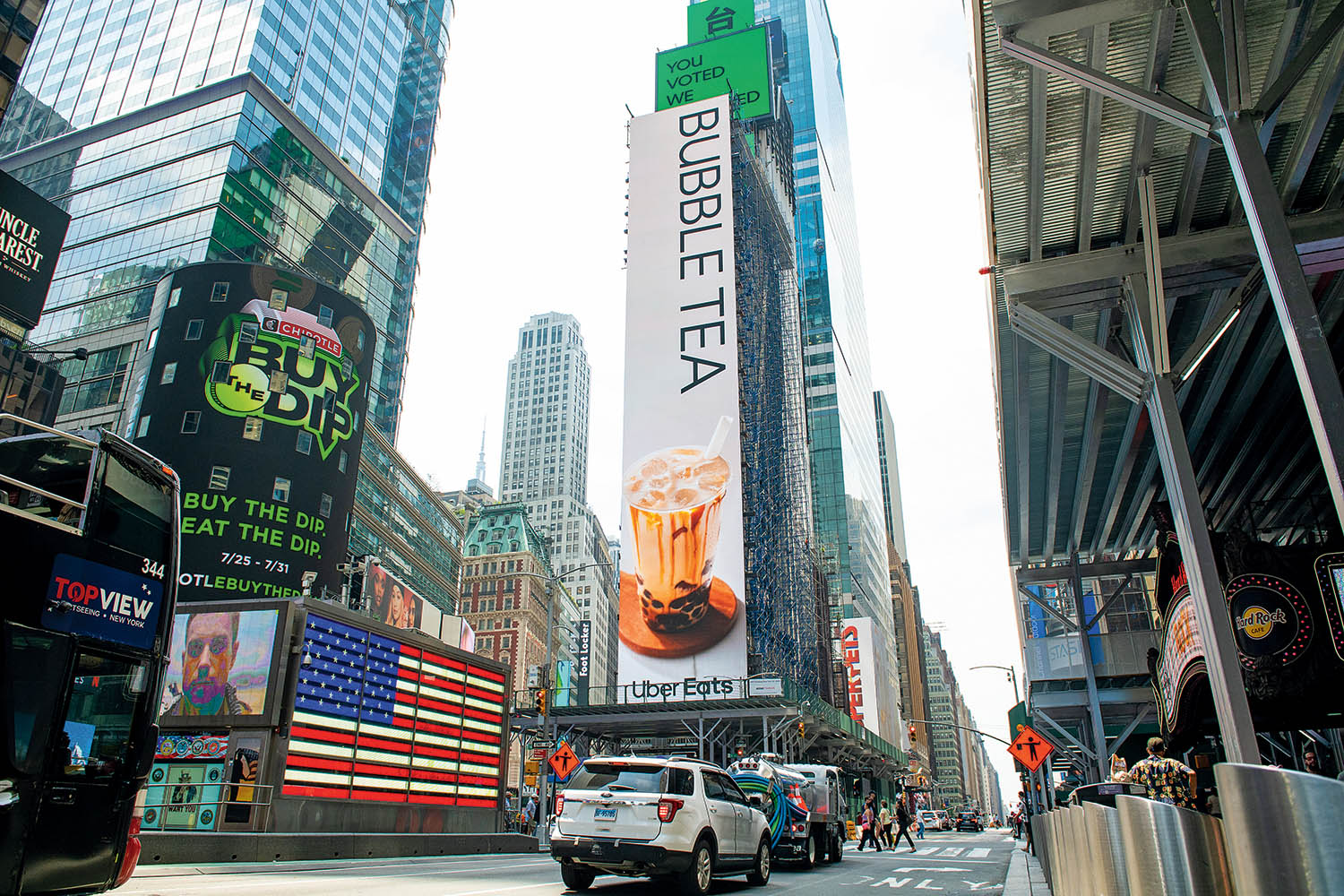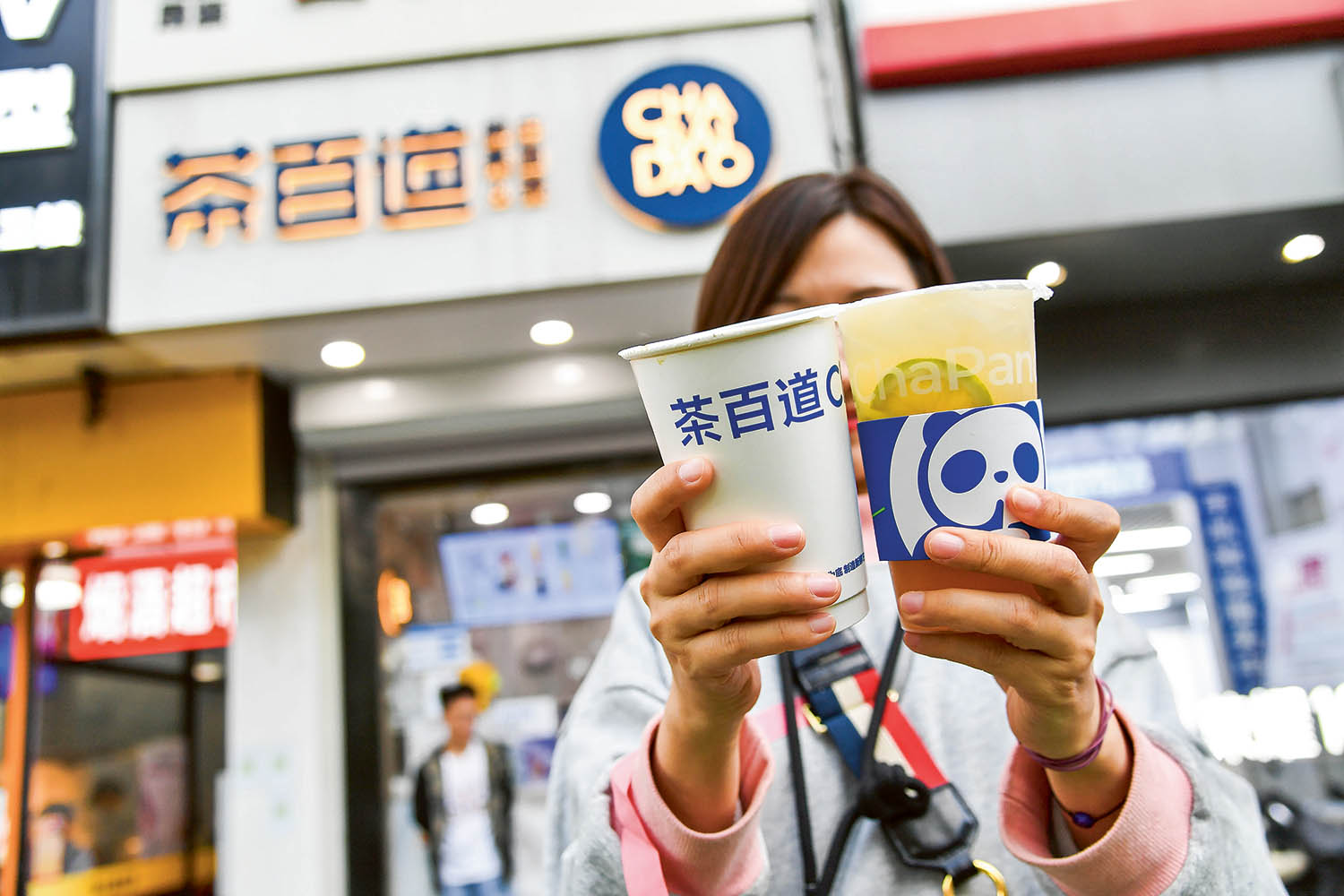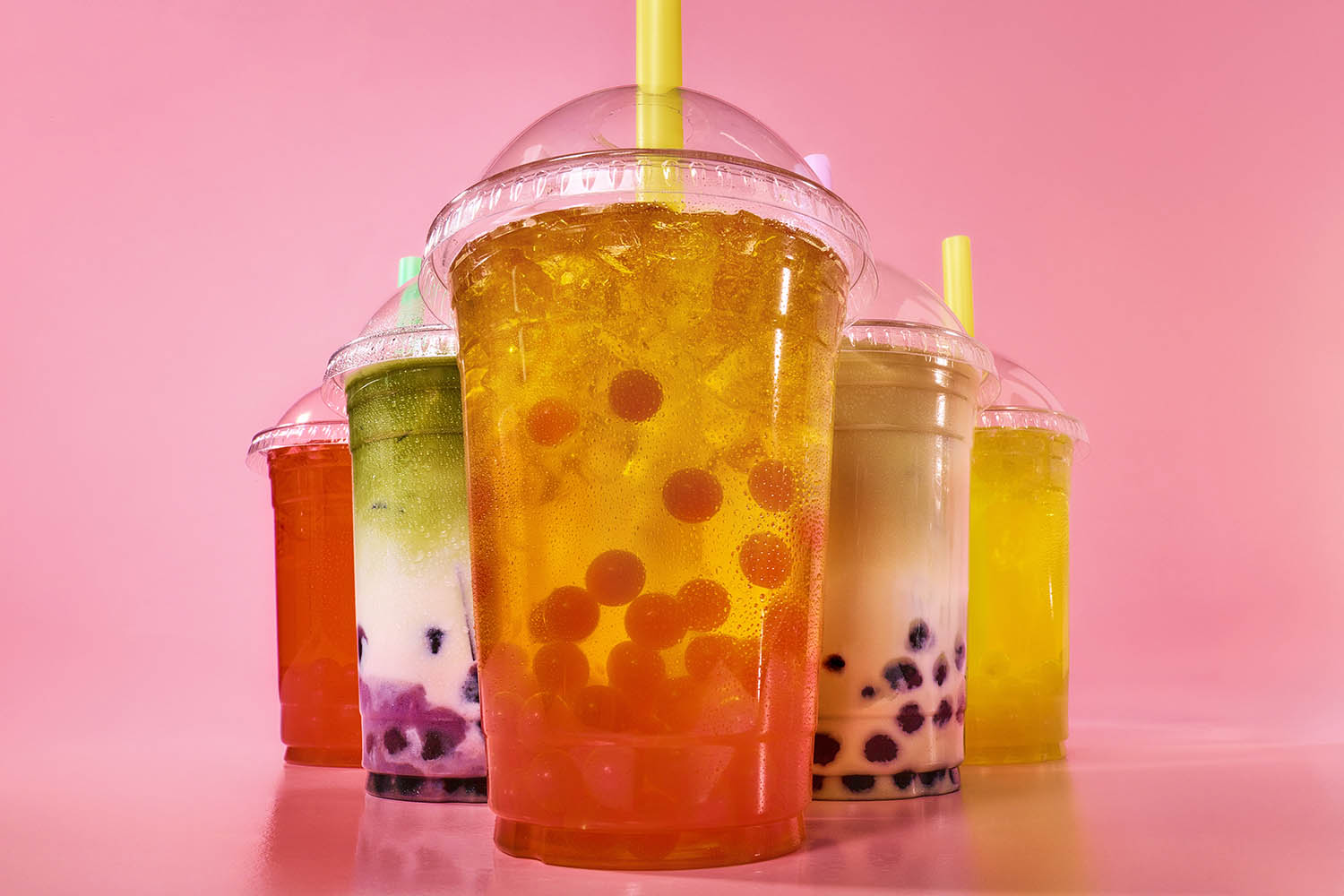Photographs by Aaron Graubart
Food stylist Rebecca Rauter
There’s a bubble-tea store I go to in London – a small Taiwanese place that always has a queue out the door. The infusions tend towards grounded beiges and browns: bu zhi chun oolong tea; over-steeped Ceylon tea with milk and dark sugar syrup; an Earl Grey latte. If you get your tea with tapioca bubbles, you’ll find they’re made to a diameter of precisely 8.5mm, which is exactly the right width to slip through the straw. My order of choice is the milk tea with roasted buckwheat – a Ceylon blend that’s rounded out with soft, nutty undertones of soba. I get it with extra tapioca pearls, standard ice, standard sweetness.
Sometimes, instead of going for coffee, I take friends here. For the people who don’t know how much they’re going to love bubble tea, it can be a lot. Bubble tea isn’t one thing, it’s an umbrella term for a miscellany of Instagrammable drinks, many of which don’t have tea, milk, or even tapioca pearls. They can be fruit-based, or blended milk with chestnut purée, or high-concept versions made from scratch with oolong and hand-rolled pearls. You choose a base tea, add-ins, sugar and ice levels, milk types and whether or not to get a top of sweet-salty cheese cream – a thick, plush foam head, which gives black tea the visuals of a pint of Guinness. Depending on the drink, you can choose hot or cold. The permutations are seemingly endless – even the most seasoned off-menu Starbucks drink aficionados can get overwhelmed by up to a thousand possible routes through the menu.
So, when they want to play it safe, I tell my friends to get the brown sugar boba milk tea – the archetypal iteration, the bubble-tea-emoji bubble tea. The milk tea is brewed to the colour of a manila envelope. It is served cold. Inside you will find the plump, brown-black tapioca pearls – also called bubbles, or boba – that have become the drink’s leitmotif. They have a texture called QQ, a kind of dense bounciness like fish balls or firm mochi. Once people try bubble tea, they tend to like it, if for no other reason than they can customise it to almost atomic alignment with their tastes. I explain all of this gently, like the elder statesman of bubble tea, as though I did not, in fact, start drinking it five years ago.
Until 2010, Britain didn’t have a standalone bubble tea shop. But here we are – there are a dozen bubble shops within a 10-minute walk of my usual place. There are more good places to get bubble tea in this area than there are to get good coffee. We have bubble tea shops in Huddersfield, Portsmouth, Guildford and Leamington Spa. Southend-on-Sea, where I grew up and which still doesn’t have a Pret, has six. Walsall has a combination bubble tea and smashburger dark kitchen. By the time Costa started selling a “tropical mango bubble frappé” in 2022, it was clear that this thing – which before you could have said was a city thing or an Instagram thing or a Taiwanese thing – had become an unignorable part of British food culture. Bubble tea is so big among Gen Z and Millennials that for the first time in my lifetime, there’s a genuine challenge to the supremacy of coffee shops. It’s a generational shift. The last time a food took off this quickly in Britain, it was the 50s, and it was hamburgers.
In mainland China, Bubble tea has a bigger market than coffee
When it comes to the British bubble-tea boom, there are two obvious questions. The first is: how did we come to love this so much? The second is: why now? Some foods evolve incrementally, over generations. A new ingredient is discovered or a technique is perfected through countless iterations of a single, everyday dish, like risotto, or roast meats on rice. Things slowly work their way into the culture – people make them, more people eat them and, eventually, people start telling stories about them, which is the point at which you know a thing has really laid down roots. It’s unusual to be able to pin down exactly when a food was invented and even rarer for it to be in living memory. They’re just there, units of cultural vocabulary with hidden roots and circular systems of meaning.
And then, there are zeitgeist-seizing foods – the ones that spread at lightspeed, becoming not just a food but the food of a generation. Usually, they’re invented by accident, but there’s something about the way that they dovetail with the culture at that moment. Burgers, customisable coffees, sliced white bread. The economics are right, the cultural plexus is ready, the networks of trade and agriculture in place. Most importantly, there’s an appetite for it. You can call these crazes or trends, but there’s always something deeper than fashion. These foods don’t just find a place in the culture, they have the power and the momentum to rearrange food culture around them. In recent years, there have been flashes in the pan – like avocado toast or cupcakes – but nothing has done it quite like bubble tea.

In Taiwan, where bubble tea was invented, people have been drinking Chinese tea styles with milk since Dutch colonisation in the 17th century. But milk tea – specifically, Indian black teas where milkiness is as important as the tea – arrived late, some time around the Second World War. As the story goes, a former bartender, Chang Fan Shu, thought to serve it cold and shake it like you would a cocktail. When he did this, the fats and proteins in the milk allowed it to form a foam and he made what people started to call bubble tea. Some shops started serving iced versions, shaken like a cocktail. And then in the 80s, in a Taiwanese tea shop, someone had the idea of adding chewy pearls of tapioca starch to the bubble tea, making bubble tea squared.
New variants quickly appeared. A lot of the time the tea was lost completely, most notably in the crystalline pop-fruit flavours, such as lychee or mulberry, although also in milkshake-like blends like lilac taro. It took centuries of culinary negotiations for milk tea to become A Thing, in any meaningful sense. And then it took a couple of years for the bubble tea Cambrian explosion to blow the whole thing apart.
Within a decade, bubble tea was huge in Taiwan and, not long after, in Hong Kong. By 2002, Singapore had 5,000 shops. It caught on in mainland China – particularly in the south where tea culture was most robust – and it was helped by the fact that tapioca was already part of dessert culture. Today, there are nearly half a million bubble tea stores in mainland China, where it has a bigger market than coffee. It went to California in the 90s, via Taiwanese-American families, and there it was known as boba tea. Within a few years, boba shops were to West Coast Asian-American kids what soda fountains were to white American teens a couple of generations before.
Even by the standards of wildly successful foods, bubbletea has been a sensation. There is no practical reason to drink bubble tea, no culture to which it is truly traditional. In fact, in most places, the point is exactly that it’s fun and unserious. Even in Taiwan it doesn’t pass the Michael Pollan “don’t eat anything your great-grandmother wouldn’t have recognised as food” test – creamer-based tea came to Taiwan after the war, and the actual boba add-in idea is from the 80s. Still, in the past few decades it has become a global export and a reminder that when you’re talking about the terroir of a food, you’re not just talking about place, but about a moment in time.
Taiwanese bloggers wrote of its hype with delighted bafflement
The first bubble tea shop chain in the UK, Bubbleology, opened in 2011. There were places where a person could find bubble tea before then: in food courts like North London’s late Oriental City, Cantonese restaurants and dumpling shops. Hardcore boba fans posted leads on the nerd-moderated backpages of the internet. But Bubbleology, on the edge of London’s Chinatown, really marketed bubble tea. In the window, there was all the paraphernalia you’d expect to find in a meth lab: a display of Erlenmeyer flasks, test tubes, beakers and snaking glass pipes. Inside the shop – a chaotic, cave-like space with a few small tables and molecular diagrams on the walls – the staff wore lab coats and worked through the orders as fast as they could, while the queue stretched out the door. You could get kumquat fruit tea, or almond milk tea, or taro, or plain Assam. For some reason, you could also get customisable cruffins.
I say all this as though I was there when it happened, which I was not, but my friend Kaila was. She was a straight-edge punk with a sweet tooth and a nebulous interest – like so many British teens at the time – in East Asian culture. She was a dream customer, not least because she had nothing to compare these bubble teas to. Kaila has this beautiful capacity to be delighted by things that a more cynical person would dismiss out of hand. It is the best thing about her. And so one day she was walking by the shop, saw the high-concept set-up and the neon colour scheme and she went on in. Her entry point was the fruit flavours. She also experimented with the popping bubbles – a squishier, juice-filled, jelly-based alternative to the bouncy tapioca, making it a drink, inside a solid, inside a drink.

Big in the Big Apple: bubble tea lights up Times Square after being elected as the number one Taiwanese icon in New York City
Around this time, in the early 2010s, lots of people who hadn’t grown up with bubble tea were suddenly “discovering” it. White people started talking about it, coy but kind of self-satisfied, comparing the QQ-ness of the boba at Café de HK and at Candy Café, or saying Bubbleology was overrated, which it was. Taiwanese bloggers wrote with delighted bafflement that this drink had become a focus of food-crowd hype. Bubbleology opened an outlet in Harvey Nichols and more bubble-tea chains like Mooboo and Ci-Tea opened up.
In a strange kind of way, British people had been primed for this. Britain has had a tea culture for hundreds of years. Or maybe it’s better to say Britain has been a tea culture: the rituals of tea are so embedded that they’ve become a point of identity. But you can’t really understand the bubble-tea explosion only by looking at historic British tea culture – just like you can’t understand Hulk Hogan by looking at Olympic wrestling. To start with, a lot of the bubble tea that British people were buying in those early days in the 2010s was fruit-based and milk-less.
In East Asia, bubble tea started from sensible milk Assam tea and got methodologically weirder, all the way through to monster crème brûlée brown-sugar hybrids. But we began at the postmodern end, in late-stage bubble tea – with super sweet, syrup-based drinks targeted at, if not children, then at least every adult’s inner child. If Brits were primed for the taste of these early neon bubble teas, it was probably by something more like Robinsons fruit squash.
What bubble tea did benefit from, however, was the growth of coffee culture. Through pumpkin-spice lattes and eggnog cappuccinos and coffee-flavoured frappés, the big chains have gently suggested that it is OK, actually, for adults to go into a coffee shop and leave with a grownup triple-XXX version of a milkshake. None of us realised this at the time, but in a way we were being groomed for bubble tea. The market research process for Bubbleology included going to Taiwan for taste tests, but it also involved staking out branches of Costa.
Is bubble tea a part of the culture now, or will time show it to be a fad?
There were hurdles, not least the best part – the tapioca. Or, as it has been described in the British press: “mysterious black lumps”. In much of East and Southeast Asia, tapioca is appreciated for its textural assets, as a sweet soup and an add-in to drinks and shaved ice. But for most pre-Millennial Brits, tapioca means tapioca pudding – a famously hated dessert in which small tapioca pearls are cooked in milk to form a porridge with a texture that people usually liken to frogspawn. People don’t have a convincing precedent for this kind of chew. It’s not even just the particular, super-charged QQ bounce of tapioca that people get weird about: it’s also the popping pearls, the grass jelly and the slurpable coconut pudding.
It’s all about timing. Bubble tea could never have taken off in Britain in the 90s, say. Everyone was still too deep in the tapioca pudding years and, besides, you can’t go from never having had anything more exciting than a Maxwell House instant coffee to choosing a micro-personalised bubble-tea order. There are intervening stages we had to live through. You have to wonder whether part of the answer to the “why now?” is just that a new generation has aged into spending power, and they don’t remember tapioca at its worst.
For all the excitement of going into a bubble-tea shop and all the seemingly limitless possibilities you find there, the rise of bubble tea in the UK was never just about taste. It wasn’t just down to the person-to-person, or Instagram-to-Instagram, transmission of culture and ideas. It always comes back to bigger, colder forces: business, the economy, import-export, property. It’s here, in the devil’s details, that bubble tea was made.
There are words that people use when they’re deciding which food businesses get financed: scalability, overheads, franchising, labour costs. So long as you don’t think too hard about the quality of the tea itself, bubble-tea shops do well on all counts. Unlike a restaurant, you don’t need to hire trained chefs – the work is skilled but formulaic. The machinery is inexpensive, especially compared to large coffee machines, which can run into the thousands. You just need a fridge, a couple of tea urns, a machine to heat-seal the cups, something for cooking the tapioca, trays and storage and cups and straws.

A customer shows her newly purchased milk tea outside Chabaidao bubble tea store in Beijing, China
But for culture to move, you need real people – peoplewho already hold and cherish these ideas. There have been various waves of migration from East Asia to the UK. There were seafarers in the late Victorian era, who set up Chinatowns near the ports, in Liverpool and London. Then there was a small cohort of students in the early 1900s. The biggest influx started in the 50s, when migration laws were changed to add to the workforce after the war. Men came to Britain from poor and rural areas of Hong Kong. They set up restaurants serving people-pleasing incarnations of Cantonese food. When the economy tanked, lots of restaurateurs pivoted to a more casual model and the British-Chinese takeaway was born.
Right now, there are two migrations from East and Southeast Asia to the UK. One group are mainly middle-class migrants from Hong Kong. The other group are students, mostly from mainland China. This second group is a vital part of the bubble-tea success story. As far as food and taste in Britain go, it’s one of the most important migrations of people in recent times.
It started in 2012, when tuition fees were raised and university funding was cut. The smart thing to do was to encourage international students to enrol – universities could set the fees higher, subsidising the whole thing with the money gleaned from comparatively wealthy kids from other parts of the world. China was an obvious site for recruitment. There are around 150,000 Chinese students in the UK today – almost three times as many as in 2011, and the same as the total number of Chinese people in the UK back in 1981. They make up the biggest proportion of international students in the country and their universities were seed crystals for British bubble-tea culture.
In the 2010s, the franchises and chains organised themselves with this in mind. I talked to the owner of an independent bubble-tea shop whose market research included searching Google for halls of residence in their area. And so, over the last 15 years, bubble tea has filtered into British tastes as quickly as Chinese takeaways did a few decades ago. In both cases, one small expression of East Asian food has found its way over here and become wildly popular at breakneck speed. In both cases, the food has entered the culture from the bottom up – the food that ordinary people eat or drink every day, instead of top- down from luxe restaurants or because the critics said so. At the point of entry, both are inexpensive and flexible – 50 years apart, a similar migration of taste.
Usually there’s a grey area when it comes to how foods hit the mainstream, but with bubble tea in the UK you can pin down the “why now?” with uncanny accuracy. The balance tipped – and the chains entered the market – over a couple of years in the early 2010s. It happened because this is when Instagram, the digital conduit for all things bubble tea, launched in the UK. It happened because this is when tuition fees tripled and universities started recruiting for students from abroad. It’s strange just how much of the roll-out of wild, postmodern, excellent Taiwanese bubble tea comes down to the nuts and bolts of business, tech and policy.
Right now it’s hard for working-class people to come to Britain through legal pathways and it’s difficult for Chinese restaurants to hire chefs. And so the foods that are most free to move are the ones that anybody, with a bit of light training, can make. The power balance tips towards delivery chains and convenience franchises – places which, even if they’re geared towards Chinese students, can fall back on tight, impersonal food-prep systems more than individual skill. Look at things from this angle and you see the conditions for diaspora restaurants, whether they’re Chinese takeaways or bubble-tea shops, are set in Westminster, in the hands of the small group of peoplewho write policy, draw up budgets and set migration laws. Who is allowed in? Under what conditions? At what income threshold? To fill what economic gap?
By the late 2010s, bubble tea had reached ubiquity. Bubble tea does well with Muslim teens – in the absence of alcohol, these shops are meeting points, just like the first wave of diaspora bubble-tea places were for California kids in the 90s. “Now, more than half of our customer base are from British, Black and Asian backgrounds,” a Gong Cha rep told food writer Angela Hui in 2022. “There’s a newfound enthusiasm from people wanting to try new things.”
Over the last few years, a British accent of bubble tea has started to creep in. When I spoke to Eric Khaw, the founder of Mooboo, he mentioned that green apple, strawberry and mango flavours are unusually popular in the UK compared to other countries. There’s a shop in Sunderland selling an Irn Bru bubble tea – an unstable isotope that goes to show how far we’ve strayed from nature’s path.
To a certain extent, bubble tea is being taken out of its original cultural context. But then, if we know anything about tea, it’s that the entire story has been about displacement, ruin and growth. The culture adapts. New ideas come out of left field. I mean, barely a generation ago, the very idea of a tapioca-centric tea drink was left field, even in Taiwan.
You have to wonder if bubble tea will exhaust itself – if it’s an intractable part of the culture now, like English breakfast tea, or whether time will show it to be a fad, a reflection of the particular economic and social circumstances of our time. But for now, it’s still going strong. I went to a food industry trade expo a while back and salespeople were demoing robotic bubble-tea machines with the soft but deliberate arms of a ballerina. There were special biodegradable straws, bubblegum-flavoured popping bubbles, talks with titles like “Breaking the Bubble: Boba Stories from the Greater Manchester Area – Utilising AI in Direct Marketing for Franchisees”.
Recently I saw a video from one of the most-popular food accounts on YouTube – a 4.5m-follower duo of Brits whose mainstay is videos of people trying new foods. You know the vibe: perky white guys who, before the collapse of mainstream broadcasting, would probably have been kids’ TV presenters. “British Taxi Drivers try Bubble Tea for the first time!” the video was called. One of them nearly choked on the pearls, someone else had trouble latching on – he couldn’t actually figure out how to suck the boba up through a straw. There are two lessons you can take from this. Firstly, that Brits continue to moan, and will probably always moan, about tapioca. But also: look at where we are, look at the change that 15 years can make. It really says something about Britain today that you have to survey a bunch of white guys, mainly in the 50 to 70 age bracket, to find someone who hasn’t tried bubble tea.
All Consuming by Ruby Tandoh (Serpent’s Tail, £18.99) is out 4 September. Order a copy at observershop.co.uk for £17.09
Photograph by Getty Images
